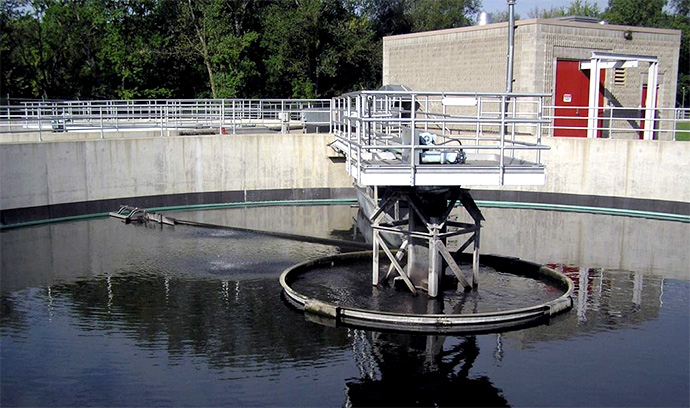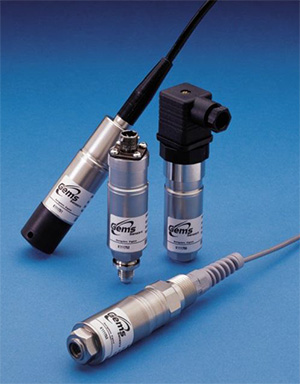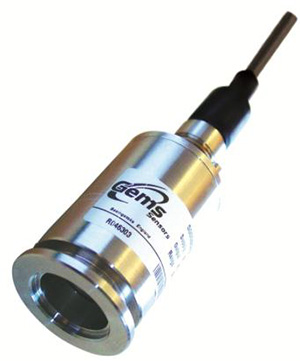Water and Wastewater Processing with Pressure
The water and wastewater industries increasingly rely on pressure transducers to offer reliability and enhanced system performance.
With dependability such an important issue in the processing of clean and waste water, the use of pressure transducers can provide a vital method of maintaining and protecting both systems and product quality. These devices can withstand particularly aggressive process conditions, extremes of temperature, mechanical shock and vibration while delivering precise control. For example, within a system that is handling abrasive slurries, a constant measurement of pump discharge pressure via transducers will reveal whether a system is coping with a blockage. If so, the transducer can trigger appropriate action that can prevent the pump from generating excessively high pressure in excess of the operating limits of the piping system.

Photo by Gems Sensors & Controls
A pressure transducer converts pressure, typically that of fluid or gas, into electrical output signals. That pressure signal can in turn also be used to make hydrostatic fluid level measurements, thereby providing level measurement capability as well. Inside a pressure transducer is a strain gauge sensor, mounted on the back of a stainless steel diaphragm, the face of which is in direct contact with the pressure media. Displacement of the diaphragm thus causes the strain gauge to flex, either in compression or under tension, with the electrical output being directly proportional to the pressure or vacuum applied. Output from the sensor is connected to onboard electronics, with the entire unit being contained within a compact and sealed stainless steel housing.
Strain Gauge Sensors Strain gauge sensors, which contain this pressure sensitive diaphragm, can be effectively manufactured using the sputtered thin film process, whereby a solid target material is bombarded by energized particles, causing the material to release atoms. The atoms that are subsequently released are deposited in layers on a stainless steel beam, which is then etched and mounted on the reverse of a stainless steel diaphragm. The application of the sputtered thin film layer during the manufacture of pressure transducers results in a sensitive, robust sensor that is suitable for direct contact with almost all liquids, oils and gases.
Chemical Vapour Deposition

Photo by Gems Sensors & Controls
Chemical vapour deposition (CVD) technology offers another highly effective method of manufacture, producing compact, accurate devices. CVD sensors can also be mass produced at low cost, since they are produced on wafers in large batches, using polysilicon deposited on a stainless steel substrate, with the strain gauge patterns being chemically milled. The wafer is then divided to produce individual sensor beams, which are laser-welded to a stainless steel summing diaphragm and pressure port, before being connected to internal electronics for signal conditioning and amplification.
Efficacy of Pressure Transducers
Advances in electronics technology have also made a strong and positive impact on the efficacy of pressure transducers. The integral electronic signal conditioning that has been supplied with these devices over recent years often incorporates advanced ASIC (application specific integrated circuits) technology, a factor that has opened up opportunities for many markets, since the performance and functionality of each transducer can be tuned to meet the specific requirements of each customer. As with CVD, the benefits of ASIC technology have included reductions in manufacturing costs and, consequently, unit costs for the end user.

Photo by Gems Sensors & Controls
Gems Sensors and Controls manufactures a range of highly versatile, resilient and submersible pressure transducers using CVD, including the 2600 Series. These devices can be used in clean water applications and offer stability and accuracy in a variety of enclosure options rated at IP65 and above. For contact with grey and black water, the 5000 Series offers a robust option with an open face construction that allows the transducer to deliver accurate results in presence of viscous liquids and solids without clogging.
The availability of such high performance components at affordable prices has inevitably led to the incorporation of pressure transducers within a variety of water and wastewater treatment facilities. The testing of these devices has resulted in some impressive statistics, measuring a response of 1ms or less to changes in pressure, accuracy with almost zero drift over time and an operating life in excess of 100 million cycles. These outstanding levels of performance and reliability have been welcomed by the water and wastewater processing sector, not only because accuracy is vital to plant safety but also because it is imperative to minimize the potential for maintenance and component replacement where equipment is difficult to access.
Pressure transducers offer robust performance even amid the harsh or corrosive media elements found in applications such as desalination plants or sewage sludge processing, while the resistance of these devices to constant vibration enables them to be used in proximity to pumps, a ubiquitous presence within the water processing industry.
For further information visit: www.gemssensors.com
News Categories
- » NEWS HOME
- » Automation & Robotics
- » Industry 4.0
- » Material Handling
- » Sensors
- » Quality & Testing
- » Machine Vision
- » Laser & Optics
- » Metalworking
- » Motion Control & Drives
- » Hydraulics & Pneumatics
- » Process Industry
- » Renewable Energy
- » Agriculture
- » Home & Office Furniture
- » Environmental Tech


